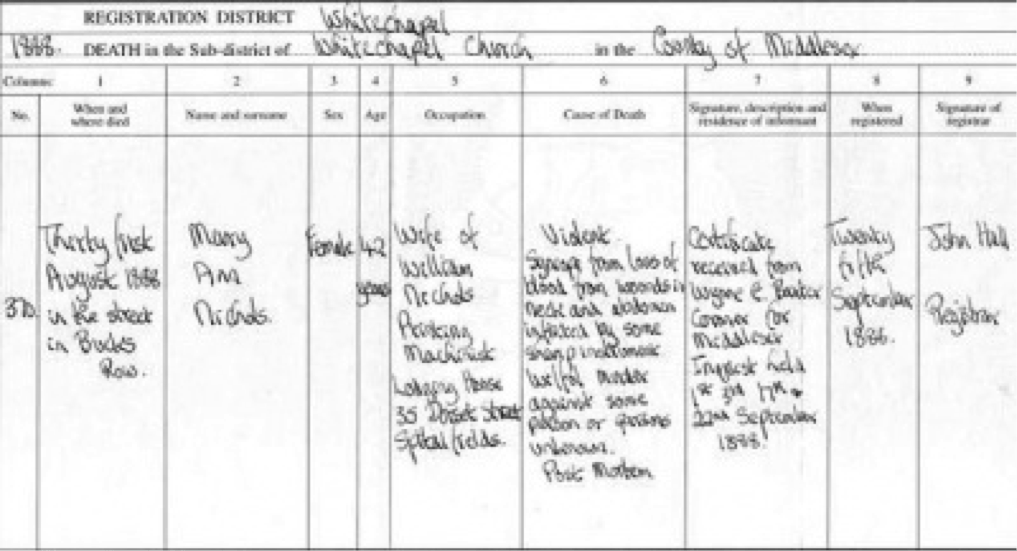Born on August 26, 1845 in London England, Mary Ann Walker was raised by locksmith Edward Walker and his wife Caroline. She married William Nichols, a printer’s machinist, in 1864; however, the couple divorced due to Mary’s drinking habits and prostitution allegations. Mary, now Mary Anne Nichols, continued practicing prostitution and was known for moving between workhouses and boarding houses, and living off charitable donations.

Prostitutes in Europe were regarded with mixed feelings in the nineteenth century. An awareness for the vulnerability of women prostitutes was fairly low and they were treated with curiosity as well as disgust. They had few economic options for making their way in the world and the women themselves were generally born into poverty and had little education or work skills. London prostitutes, especially those who operated on the streets, regularly picked the pockets of the men they preyed on. They kept an eye out for drunkards, from whom they could steal without the risk of being caught. However, this wasn’t the case with Mary as she herself spent most of her waking hours under the influence. Prostitution was very much frowned upon in London, and the women engaging in the profession were seen as the lowest of the low. It wasn’t unusual for men to beat and kill a prostitute after a ‘session,’ so when Mary Ann was found dead with her skirt lifted above her stomach, it was nothing out of the ordinary.1
The night in question was August 30, 1888. A heavy rain was falling on London during one of the coldest and wettest summers on record. Mary Ann was last seen walking down Whitechapel Road, and more than likely she was there soliciting her trade. Prostitution was a very dangerous profession one hundred thirty years ago. With no proper policing and the women themselves looked upon as animals, people would do with them as they pleased. No wonder the infamous ‘Jack the Ripper’s’ victims were all prostitutes.2 They were easy targets, and he was able to get away with murder.
Nichols was often found in the lodging house on 18 Thrawl Street; however, on this specific night she was knocked back due to a lack of money.3 Mary wasn’t fazed by this though, and was on her way back to her ‘office,’ the streets. At 2:30 am she ran into Emily Holland, another worker, who described Mary to be drunk and staggered against a wall. She told Emily that she was off to find another ‘punter’ in an attempt to get her ‘doss’ money in order to rest her head that night.4 One can’t help but think that Mary was selected by Jack because of her drunkenness and through no fault of her own she was destined to a brutal ending because she was such an easy victim. Emily Holland was the last known person to interact with Mary, and only one hour later, at 3:40 am, the latter was found cold and lifeless on the side of Bucks Row, a mere ten minutes walk from where the interaction took place.5

Constable Thain and Sergeant Kerby both passed down Bucks Row at 3:15, but reported nothing out of the ordinary. One must wonder what Nichols was doing from 2:30 to 3:40. She was only ten minutes away from Bucks Row, yet was found dead there seventy minutes later. Another thought would be: what was Jack the Ripper doing during that time. 6
Nichols’ body was initially found by two workmen, who both decided to leave her lying, as they didn’t want to be late for work. However, they let a police officer know her whereabouts on their way. Major bruising was found on Mary’s body and five of her teeth were missing. Investigators put this down to the struggle. Nevertheless, there were several deep cuts along her abdomen, which shows that her attacker enjoyed closeness with his victim, whom he supposedly raped and then mutilated. One can only speculate on why these cuts were made as they were, in no pattern, and didn’t relate to anything. As the first kill, maybe Jack was experimenting with Mary, and she was some sort of sick puppet in which his fantasies could be played out.7

Mary was buried on Thursday, September 6 of that year in the City of London’s Cemetery.8 Two days later, another of Jack’s victims, Annie Chapman, was found in the back garden of a London flat.9 Her womb had been removed and her body left horrifically mutilated. Jack the Ripper had indeed struck a second time. He wasted no time in preparing his second victim, yet this time it was more brutal than the first. One may wonder if Jack had attempted to remove Mary’s womb, but was perhaps disturbed and fled the scene before he could complete the operation.10 Jack the Ripper’s third victim was Elizabeth Stride. She was found at 1:00 am in Dutfield’s Yard, London. The fact that her throat had been cut, but the rest of her body had not been touched, led to speculation that her killer had been interrupted. This links with Mary Ann’s case because it is believed that Jack was also interrupted while working on her. One may believe that Jack liked the excitement of being caught, as he seemed to carry out his kills in the middle of streets. The fourth victim was found in Mitre Square in the City of London at 1:45 am. Catherine Eddowes was savagely mutilated by The Ripper, as her face was torn off and her uterus was missing along with her kidney. Clearly, Jack had not been interrupted this time. On November 9, the body of Mary Kelly was found in her room in Miller’s Court at 10:45 am. She had been virtually skinned to the bone and many experts believed that she was Jack the Ripper’s final victim. This was a fitting finale for the sick monster, as he chose a private area in order to carry out his most disturbing kill of all.11
For well over one hundred years since the time of the murder of Mary Ann and the rest of Jack’s victims, the identity of the killer has been regularly questioned, with nearly one hundred suspects having been named in the process. While many theories exist, none of them have proven to be indisputably convincing. Many think the Ripper was a commoner, possibly a butcher or other tradesman, who lived locally and was employed during the week, explaining why the murders occurred on or near the weekend. A lot of experts also agree that the Ripper was a local to Whitechapel. One of the most compelling suspects was Thomas Hayne Cutbush, who was a violent youth diagnosed insane at the time of the murders in 1888, and was believed to be wandering the streets of London throughout the time of the killings. Subsequently, the murders then stopped after Cutbush was locked up. Disappointingly, this information, along with more evidence, did not prove that Cutbush and Jack the Ripper were the same man; but there was enough evidence to keep Cutbush on the suspect list.12
The finger of suspicion was first pointed at Cutbush in 1894, by The Sun newspaper.13 The article claimed that despite the popular theory of the Ripper being dead, he was in fact a mental patient. The Sun’s detailed description clearly resembled that of Cutbush. The suspicion was that the Metropolitan Police covered up his guilt to avoid the embarrassing outcry that would have followed if the country’s most feared serial killer was found to be Superintendent Henry Cutbush’s nephew. Henry was a high ranked officer, whose reputation could have been seriously damaged if his relative was found to be Jack the Ripper. This is another reason why Thomas Cutbush was actively considered as a suspect.
Some named Cutbush as the No 1 Ripper suspect, but others have strongly denied this theory. Its main weakness is that the last known Ripper victim died in November 1888, at the end of the eleven week killing spree. If Cutbush was the killer, it seems odd that he would commit five murders over such short a period of time, stop for more than two years, and then commit one more assault, in which his victim survived. But there is almost no chance that the case will ever be solved. Thomas Hayne Cutbush remains top of the suspect list.14
It’s an eerie thought that this case will never be solved and even if it is, there is no one to suffer the consequences. It’s even scarier to think that there may currently still be serial killers on the run now that will also never be found and charged for their crimes. There will never be any justice for Jack the Rippers victims, but they can be certain they will never be forgotten.
- Mary Spongberg, The Body of the Female Prostitute in the Nineteenth-Century (New York, NY: New York University Press, 1997), 83-85. ↵
- Encyclopaedia Britannica, July 1998, s.v, “Jack the Ripper, English Murderer,” by John Phillip Jenkins. ↵
- Knocked back means dismissed. ↵
- A punter is a client. Doss is rent. ↵
- Stephen P. Ryder, “Casebook Jack the Ripper,” Victims: Last Addresses, August 14, 2009, 2, www.casebook.org/victims/polly.html. ↵
- Stephen P. Ryder, “Casebook Jack the Ripper.” Victims: Last Addresses, August 14, 2009, 2, www.casebook.org/victims/polly.html. ↵
- Salem Press Encyclopedia, January 2016, s.v. “Jack the Ripper,” by Cait Caffrey. ↵
- Death Certificate: no.370. 25 September, 1888. http://www.casebook.org/victims/polly.html ↵
- A back garden is a backyard. ↵
- William D. Rubenstien, “The Hunt For Jack the Ripper,” Ripper Diaries, (May 2000): 1-3. ↵
- Richard Jones, “Jack The Ripper 1888,” Victims (13 March 2016): 3. ↵
- Andy McSmith, “Madman’s notes throw new light on Ripper case,” The Independent article London, (19 November 2008). ↵
- A tabloid newspaper published in the United Kingdom and Ireland. ↵
- Richard Wheatsone, “Ripping Discovery,” The Sun (16 September 2017). ↵



211 comments
Alondra Aviles
Jack the Ripper has created quite an impact and a very infamous name for himself. It’s gruesome to think about how he followed through with all of his crimes. The article was almost chilling, concluding with a fair warning of what people are capable of. The case uncovers many questions about the murderer and creates a storyboard of speculation. Much like how this article did. It was interesting, well written, and overall a great topic. It’s astonishing how this person could have continuously brutally murdered women and continuously got away with it. It serves as a warning to many; It’s important to be safe when wandering alone, I have always been told to maintain distance between any stranger around me and to make sure and tell a friend or family member of when and where I’m going.
Abigale Carney
This was a very interesting article! I have heard of the many brutal killings of Jack the Ripper, but I have never heard any specific names or situations that had taken place. The minds of serial killers are so confusing to me, because they are so demented and hard to understand. The mutilation of Jack the Ripper’s victims is so gruesome, and I am so sad to hear of people who actually enjoy committing these awful crimes.
Amanda Cantu
Great article, I found it very informative. I never really knew much about Jack the Ripper other than the fact that he was a serial killer in London. Learning about his victims and what he did to the victims reminds me of scenes from a horror movie. It’s sad to say that there’s always not enough information to catch the killer. Those girls deserve justice and they will never get it simply because the Ripper was sadly good at what he did. Like many cases this will forever be unsolved but the story will go on forever. Lets just say people should really learn how to watch out for ourselves and other because you never know what someone is capable of until it is to late.
Teresa Valdez
This article tackles Jack the Ripper through an unique perspective. Through Mary Ann Nichols, a narrative forms around a strong central character and an antagonist. The detail of the article gave a lot of insight that was enlightening about each of the cases. It is interesting that at the time Cutbush was incarcerated, the Ripper murders stopped. It is very plausible that he was the murderer. As one of the most popular unsolved mysteries, it frustrates me that we will never be able to know who committed these atrocities.
Crystalrose Quintero
It was shocking to read in this article that murder of prostitutes was not unusual for the 1800’s. Oddly enough its unfortunate to read that her body was found early on but left there because people were on their way to work. The primary source image was so interesting to see the records of that unfaithful night also. The murder description were sad but also written so interesting and really opened my mind to how the murders actually occurred.
Jazmin Pizana
I have heard of Jack The Ripper but never knew in detail of the crimes he committed. It’s horrific to learn about the crimes he committed and the poor victims who suffered that fate. This article has really shined some light on who Jack the Ripper was. It’s terrifying that he was never caught and there was not enough evidence to convict the suspect.
Matthew Rios
Luckily, it’s harder to commit these types of heinous crimes without being caught eventually. Being a serial killer in Jack’s time was too easy for him. Murdering people left and right in the streets tells us this. His time wasn’t filled with the technology that we have today unfortunately. At least we no longer live in such an age.
Cameron Ramirez
Jack the Ripper is an infamous bad guy, even in this day in age, many people still know or have heard about Jack the Ripper. I can’t imagine living in London during the time that Jack the Ripper was still at large. Anyways, your article was fascinating, and it was a good read. It flowed well and made sense when reading. Keep up the good work, and I hope to read another one of your articles.
Rebekah Esquivel
I have heard the story of Jack the Ripper many times and I think this article described the story great. I do also find it really scary that there are serial killers free today that may never be caught. This Jack the Ripper case is so old that justice for these victims will never be given and the person behind these murders is long gone. I do hope one day there will be some kind of system invented to make crime investigation sophisticated enough to leave no unsolved crimes. It leaves fear in society and doesn’t provide closer for victims and their families. Overall, this was a very interesting article to read.
Clarissa Bustamante
I remember the story Jack the Ripper when I was a kid. I think that the article really portrayed the theme very well. This article caught my attention because I would always here about him but I never actually thought that there was actual cases amongst it. Reading about Jack the Ripper in this article gave me so much more knowledge than what I had before and also brought the story back to life again and sought to be real. Overall the article was very good in detailed and in setting the mood and tone of the article.